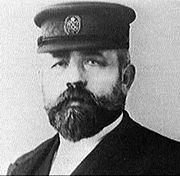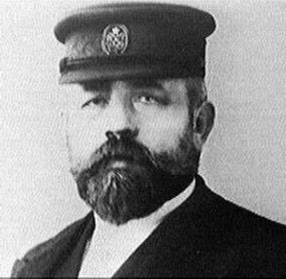Parents Emile-Justin Menier Name Henri Menier | Religion Catholic Nationality French | |
 | ||
Full Name Henri Emile Anatole Menier Occupation Businessman, Adventurer, Race car driver Spouse(s) Helene Thyra de Seillieres Died September 6, 1913, Vaureal, France Known for Anticosti Island, Chateau de Chenonceau | ||
Resting place Pere Lachaise Cemetery Grandparents Antoine Brutus Menier | ||
ANTICOSTI NOTISKUAN Lîle aux 166 000 cerfs d'Henri MENIER
Henri Emile Anatole Menier (July 14, 1853 – September 6, 1913) was a French businessman and adventurer and a member of the Menier family of chocolatiers. Born in Paris, he was the son of Emile-Justin Menier and grandson to Antoine Brutus Menier who founded the Menier Chocolate company. On his father's death in 1881, Henri Menier became mayor of Noisiel, an office he held for 32 years until his death in 1913. The beneficiary of a substantial fortune, and having a large annual income from the family business, Henri Menier spent a great deal of his time and money pursuing various leisure interests, notably yachting and auto racing. As the eldest son, Henri Menier was the titular head of the company but the day-to-day management would mostly be left to his very capable brother Gaston.
Contents

A member of the governing council of the Yacht Club de France, Menier studied naval architecture and yacht design. He owned several large sailing and steam powered yachts and journeyed to numerous European ports and with his a group of friends including René Waldeck-Rousseau, sailed north to Iceland and Norway. Menier undertook a three-year-long voyage through the Mediterranean and Adriatic Seas, the Suez Canal and the Red Sea. He also sailed across the Atlantic Ocean several times to visit a large island property he owned in the Gulf of St. Lawrence in Canada.
When automobiles made their debut, Henri Menier was one of the few who could afford them. He became a racing enthusiast and helped found the Automobile Club de France which would organize the 1906 French Grand Prix, the world's first Grand Prix motor racing event, at the Circuit de la Sarthe, in Le Mans. Menier took part in the 1902 Gordon Bennett Cup Paris to Innsbruck auto race and won the silver medal in the touring car category.
Avid hunters of deer on horseback, Henri Menier and his brothers acquired more than 13,000 acres (53 km²) of forested land in the Picardy region as well as in the Val-d'Oise département where Henri owned a château in the town of Vauréal. In April 1913 Henri Menier also bought the Château de Chenonceau in France's Loire Valley which today is still owned by family members and is a major tourist attraction.
Anticosti Island development
In 1895, Henri Menier bought Anticosti Island at the mouth of the St. Lawrence River in Canada from a British logging company. Originally granted to Louis Jolliet as a seigniory by King Louis XIV, it is a large and heavily forested island and at 217 km in length and 16–48 km wide is one-quarter the size of the country of Belgium.
Menier used it for business as well as a private game reserve, bringing in a variety of wild animals native to Canada including foxes, fishers, reindeer, bison and moose. One of the other species Menier introduced was a herd of 220 white-tailed deer who, because there were no natural predators, thrived. The island's deer population is now is estimated at well over 100,000. Along with its 24 rivers and streams bountiful with salmon and trout, it is today a paradise for paleontologists, bird watchers, hikers, and a major draw for anglers and hunters, particularly those from the United States.
Henri Menier named the 70 metre high Vauréal Falls on Anticosti Island after the town of Vauréal in France where he owned a home. At Anticosti, he hoped to set up a seigniory that could be self-supporting. He first established a settlement at Bay Sainte-Claire in 1895 but the bay proved too shallow for the large ships he would need. In 1900, he moved the settlement to Ellis Bay and established Port-Menier along the waterfront with a 1,000 meter wharf. He invested a substantial amount of money to construct a sawmill to service the logging operations that harvested softwood timber for building lumber and Wood pulp for the manufacture of paper products. The community was centered around a new cannery business designed to take advantage of the abundant supply of fish and lobsters. The town had its own hospital, school, Roman Catholic church, general store, bank, bakery, hotel, plus homes and rooming houses for the workers, and 30-room Scandinavian-style mansion for himself. Once completed, the island was home to 800 permanent residents, most of whom were French Canadians. Residents and businesses obtained supplies from a sailing ship Menier operated between Quebec City and the Gaspé, and obtained coal from the mines at Sydney, Nova Scotia.
In June 1911, Henri Menier married Hélène Thyra de Seillières who shared his love of the outdoors. However, a diabetic, he died childless a little more than a year after his marriage. He was buried in the Père Lachaise Cemetery. His brother Gaston became the owner of Anticosti Island. He used and maintained it for a time but eventually decided it was not an economically viable proposition and sold it to the Wayagamack Pulp and Paper Company in 1926. Many of the original houses still stand today.
Rue Henri Menier in Sept-Îles, Quebec was named in his honor.
